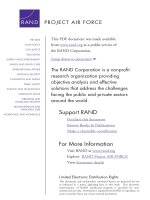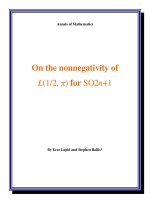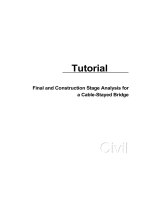Risk Analysis for Engineering 1 potx
Bạn đang xem bản rút gọn của tài liệu. Xem và tải ngay bản đầy đủ của tài liệu tại đây (1.48 MB, 30 trang )
• A. J. Clark School of Engineering •Department of Civil and Environmental Engineering
CHAPTER
1
CHAPMAN
HALL/CRC
Risk Analysis in Engineering and Economics
Risk Analysis for Engineering
Department of Civil and Environmental Engineering
University of Maryland, College Park
INTRODUCTION
CHAPTER 1. INTRODUCTION
Slide No. 1
Societal Needs
̈ Risk analysis is becoming very important
tools for modern industrial societies.
̈ The abundance of information in these
industrial societies does not necessarily
gives certainty.
̈ In fact, these abundance of information can
sometimes leads to errors in decision
making, and hence to undesirable
outcomes. Therefore, risk analysis is
needed.
CHAPTER 1. INTRODUCTION
Slide No. 2
Risk Analysis
̈ Risk analysis should be performed using a
systems framework that need to account for
– uncertainties in modeling (system architecture),
– Behavior (physical laws),
– prediction models,
– interaction among a system's components, and
– impacts on the system and its surrounding
environment.
CHAPTER 1. INTRODUCTION
Slide No. 3
Risk Analysis
̈ Example 1: Identification of Risk in a Truss
Structural System
A Truss Structural System
29 structural members
CHAPTER 1. INTRODUCTION
Slide No. 4
Risk Analysis
̈ Example 1 (cont’d): Identification of Risk in
a Truss Structural System
– The system can be thought as system in
series.
– If one of the truss 29 members fails, then the
whole system fails to function and may
collapse.
– Therefore, the potential modes of failure can
be identified and the associated risks must be
assessed.
CHAPTER 1. INTRODUCTION
Slide No. 5
Risk Analysis
̈ Example 1 (cont’d): Identification of Risk in
a Truss Structural System
– A design could be enhanced to allow for
partial failures instead of catastrophic failures
and to introduce redundancy through the
addition of some members to work as standby
or load-sharing members to critical members
in the structure
.
– Enhancements may include:
• increasing design strength; and
• reducing the failure likelihood and associated
failure consequences to acceptable and safe
levels.
– Construction costs will increase – tradeoffs.
CHAPTER 1. INTRODUCTION
Slide No. 6
Risk Analysis
̈ Example 2: Identification of Risk in a Water
Pipeline System
B
r
a
n
c
h
2
Branch 3
City
C
B
r
a
n
c
h
1
Source
A
Source
B
Pumping
Station
City Water Pipeline System
CHAPTER 1. INTRODUCTION
Slide No. 7
Risk Analysis
̈ Example 2 (cont’d): Identification of Risk in
a Water Pipeline System
– Assuming that either source alone is sufficient
to supply the city with water, failure can
happen in branch 1 or branch 2 or branch 3.
– Designers and planners of the pipeline
system, therefore, have to identify possible
areas and sources of failure, and assess
associated risks.
CHAPTER 1. INTRODUCTION
Slide No. 8
Risk Analysis
̈ Example 2 (cont’d): Identification of Risk in
a Water Pipeline System
– Example failure scenarios
Source of Failure Type of
Failure
Impact on System or
Consequences
Total or
Partial
[T] or [P]
Partial System
Failure
[P]
Total System
Failure
[T]
Failure of Branch 1 only T P
Failure of Branch 2 only T P
Failure of Branch 3 only T T
Failure of Branch 1 and 2 only T T
Failure of Branch 1 and 3 only T T
Failure of Branch 2 and 3 only T T
Failure of Branch 1, 2 and 3 T T
Failures Possibilities and Their Impacts on Water Pipeline System
CHAPTER 1. INTRODUCTION
Slide No. 9
Risk Analysis
̈ Example 3: Identification of Risk in a Fire
Escape System
DeathNoNoScenario 4apartment
Sever InjuryYesNoScenario 3in an
DeathNoYesScenario 2initiated
No InjuryYesYesScenario 1Fire
NoYesNoYes
Consequences in terms of
Life Loss
Occupants
Managed to
Escape
Smoke Detector
Working
Successfully
Escape ScenariosSource of Risk as an
Adverse Event
CHAPTER 1. INTRODUCTION
Slide No. 10
Risk Analysis
̈ Example 4: Risk Analysis in Project
Management
– In construction projects, managers and clients
commonly pursue areas and sources of risks
in all the phases of a project from feasibility to
disposal or termination.
– The methods can be applied by developing
risk scenarios associated with failure states for
all project phases by using methods that
examine causes and effects.
CHAPTER 1. INTRODUCTION
Slide No. 11
Risk Analysis- Example 4
Source of Risk in
the Project Stages
Failure
State
Cause of Failure Effect on the Project
1. Feasibility study Delay Feasibility stage is
delayed due to
complexities and
uncertainties associated
with the system.
The four stages of the project
will be delayed causing problems
to the client’s financial and
investment obligations.
2. Preliminary
design
Approval
not granted
The preliminary design
is not approved for
various reasons caused
by the architect,
engineer, project
planner, or project
manager.
The detailed design will not be
ready for zoning and planning
approval, and for the selection
process of contractors causing
delay accumulation in finishing
the project leading to additional
financial burdens on the client.
3. Detailed design Delay The detailed design
performed by the
architect/engineer is
delayed.
The project management
activities cannot be performed
efficiently, and the contractor
cannot start work properly
causing delays in the execution
of the project.
4. Execution and
implementation
Delay or
disruption
The execution and
implementation stage is
delayed or disrupted as
a result of accidents.
The project will definitely not be
finish on time and will be
completed over budget causing
serious financial problems to the
client.
5. Disposal or
termination
Delay The termination stage is
delayed or not
scheduled.
The system will become
unreliable and hazardous causing
customer complaints and the
increasing client’s contractual
obligation problems.
CHAPTER 1. INTRODUCTION
Slide No. 12
System Framework
̈ A generalized systems formulation is
needed for understanding:
– the nature of a problem,
– underlying physics,
– Processes, and
– activities.
̈ In a system formulation, an image or a
model of an object that emphasizes some
important and critical properties is defined.
CHAPTER 1. INTRODUCTION
Slide No. 13
System Framework (cont’d)
̈ System definition is usually the first step in
an overall methodology formulated for
achieving a set of objectives.
̈ Each level of knowledge
that is obtained
about an engineering problem defines a
system to represent the project or the
problem.
CHAPTER 1. INTRODUCTION
Slide No. 14
System Framework (cont’d)
̈ Example 5: System Boundary Identification
for a Truss Structural System
System boundaries can include:
• The twenty-nine members alone, or
• Including the supports, the roller and the pin, or
• Including the piers and foundation.
CHAPTER 1. INTRODUCTION
Slide No. 15
System Framework (cont’d)
̈ Example 5 (cont’d): System Boundary
Identification for a Truss Structural System
– Another extension of boundaries might
require:
• a group of similar trusses creating a hanger,
• a roofing system for a factory, or
• a multilane bridge.
– In this case of multiple trusses, bracing
members or roofing structure connected to the
trusses need to be included.
CHAPTER 1. INTRODUCTION
Slide No. 16
System Framework (cont’d)
̈ Example 6: System Boundary Identification
for a Water Pipeline System
B
r
a
n
c
h
2
Branch 3
City
C
B
r
a
n
c
h
1
Source
A
Source
B
Pumping
Station
• The system can be defined to consist of three long pipes.
• Some analyses might consider the shapes (layouts) of these
pipes and whether they have different sizes or connected by
intermediate valves and/or pumps.
CHAPTER 1. INTRODUCTION
Slide No. 17
System Framework (cont’d)
̈ Example 7: System Boundary Identification
for a Fire Escape System
DeathNoNoScenario 4apartment
Sever InjuryYesNoScenario 3in an
DeathNoYesScenario 2initiated
No InjuryYesYesScenario 1Fire
NoYesNoYes
Consequences in terms of
Life Loss
Occupants
Managed to
Escape
Smoke Detector
Working
Successfully
Escape ScenariosSource of Risk as an
Adverse Event
CHAPTER 1. INTRODUCTION
Slide No. 18
System Framework (cont’d)
̈ Example 7 (cont’d): System Boundary
Identification for a Fire Escape System
– Planners and designers may view the system
boundary to only include the fire escape
system from inside to outside the apartments.
– Another perspective might be to consider
other escape routes inside the building that
are not designated as fire-escape routes,
especially for those apartments in higher
levels of the building (e.g., roof and adjacent
structures).
CHAPTER 1. INTRODUCTION
Slide No. 19
System Framework (cont’d)
̈ Example 7 (cont’d): System Boundary
Identification for a Fire Escape System
– The system boundaries can be extended to
include external escape routes.
– Also, the system boundaries could extend
beyond the location of the building to include
communication links and response of fire and
rescue units and personnel.
CHAPTER 1. INTRODUCTION
Slide No. 20
Knowledge and Ignorance
̈ Knowledge:
– Knowledge can be viewed to consist of two
types:
• Nonpropositional
• Propositional
– The nonpropositional
knowledge can be
further broken down into:
• know-how and concept knowledge
• familiarity knowledge (commonly called object
knowledge)
CHAPTER 1. INTRODUCTION
Slide No. 21
Knowledge and Ignorance (cont’d)
̈ Knowledge (cont’d):
– The know-how and concept knowledge
requires someone to know how to do a
specific activity, function, procedure, etc., such
as riding a bicycle.
– The concept knowledge can be empirical in
nature, e.g., large, hot, dark.
– The object knowledge is based on a direct
acquaintance with a person, place or thing, for
example, Mr. Smith knows the President of the
United States.
CHAPTER 1. INTRODUCTION
Slide No. 22
Knowledge and Ignorance (cont’d)
̈ Knowledge (cont’d):
– Mr. Smith knows that the Rockies are in North
America. This proposition can be expressed
as
Mr. Smith knows that the Rockies are in North America
S knows P
Where
S is the subject, i.e., Mr. Smith; and
P is the proposition or claim that “the Rockies are in North America
CHAPTER 1. INTRODUCTION
Slide No. 23
Knowledge and Ignorance (cont’d)
̈ Knowledge (cont’d):
– Epistemologists require the following three
conditions for making a claim and in order to
have a true proposition:
• S must believe P,
• P must be true, and
• S must have a reason to believe P, i.e., S must be
justified in believing P.
– The justification in the third condition can take
various forms; however, simplistically it can be
taken as justification through rational
reasoning or empirical evidence.
CHAPTER 1. INTRODUCTION
Slide No. 24
Knowledge and Ignorance (cont’d)
̈ Knowledge (cont’d):
Knowledge Types, Sources and Objects
CHAPTER 1. INTRODUCTION
Slide No. 25
Cognition and Cognitive Science
̈ Cognition: is defined as the mental
processes of receiving and processing
information for knowledge creation and
behavioral actions
.
̈
Cognitive Science: is the interdisciplinary
study of mind and intelligence. Cognition
science deals with
– Philosophy
– Psychology
– Linguistics, etc.
CHAPTER 1. INTRODUCTION
Slide No. 26
Cognition and Cognitive Science
̈ Cognitive science claims that the human
mind works by representing information
and computation using empirical
conjecture.
̈ Limitations of Cognitive Science:
– Emotion: Cognition science neglects the
important role of emotions in human thinking.
– Consciousness:
Cognition science ignores
the importance of consciousness in human
thinking.
CHAPTER 1. INTRODUCTION
Slide No. 27
Cognition and Cognitive Science
– Physical environments: Cognitive science
disregards the significant role of physical
environments on human thinking.
– Social factors: Humans deal with various
dialectical processes in ways that cognitive
science ignores.
– Dynamic nature: The mind is dynamic
system, not a computational system.
– Quantum nature: Human thinking cannot be
computational in the standard sense, so the
brain must operate as a quantum computer.
CHAPTER 1. INTRODUCTION
Slide No. 28
Quantum Knowledge
̇ Reality is perceived as a continuum in its
composition of objects, concepts and propositions.
̇ Knowledge is constructed in quanta by humans
to meet their cognitive abilities and limitations.
̇ Quantum knowledge leads to ignorance
manifested in the form of blind ignorance, or
incompleteness and/or inconsistency.
̇ Uncertainty (generally ignorance) needs to be
portrayed in meaningful manner/forms/measures.
CHAPTER 1. INTRODUCTION
Slide No. 29
Human Knowledge and Ignorance
̈ In general, engineers, scientists, and even
most humans tend to focus on what is
known and not on the unknowns.
̈ Engineers and scientists tend to
emphasize knowledge and information,
and sometimes intentionally or
unintentionally discard ignorance.
̈ Knowledge could be misleading in some
situations.
CHAPTER 1. INTRODUCTION
Slide No. 30
Human Knowledge and Ignorance
This square
represents the
evolutionary
infallible
knowledge (EIK).
The intersection of the
two squares represents
knowledge with infallible
propositions (IK).
Ignorance within RK
due to, for example,
irrelevance.
This square
represents the current
state of reliable
knowledge (RK).
Ignorance outside RK
due to, for example,
the unknowns.
Expert A
R
KEI
K
I
K
∩
=
CHAPTER 1. INTRODUCTION
Slide No. 31
Human Knowledge and Ignorance
̈ Infallible knowledge (IK) can be defined as
knowledge that can survive the dialectical
processes of humans and societies and
passes the test of time and use.
̈ This infallible knowledge can be
schematically defined by the intersection
(∩) of the two squares.
̈ Two primary types of ignorance can be
identified:
CHAPTER 1. INTRODUCTION
Slide No. 32
Human Knowledge and Ignorance
1. Ignorance within the knowledge base
(RK) due to factors such as irrelevance.
2. Ignorance outside the knowledge base
due to unknown
̈ Objects
̈ Interaction
̈ Laws
̈ Dynamics
̈ Know-how
CHAPTER 1. INTRODUCTION
Slide No. 33
Classifying Ignorance
CHAPTER 1. INTRODUCTION
Slide No. 34
Classifying Ignorance (cont’d)
̈ Ignorance can be classified based on the
following three knowledge sources:
– Know-how ignorance can be related to the
lack of, or having erroneous, know-how
knowledge. Know-how knowledge requires
someone to know how to do a specific activity,
function, procedure, etc., such as riding a
bicycle.
– Object ignorance can be related to the lack of,
or having erroneous, object knowledge.
CHAPTER 1. INTRODUCTION
Slide No. 35
Classifying Ignorance (cont’d)
Object knowledge is based on a direct
acquaintance with a person, place, or thing;
for example Mr. Smith knows the President of
the United States.
– Propositional ignorance can be related to the
lack of, or having erroneous, propositional
knowledge. Propositional knowledge is based
on propositions that can be either true or false;
for example, Mr. Smith knows that Rockies are
in North America.
CHAPTER 1. INTRODUCTION
Slide No. 36
Ignorance Hierarchy
̈ The following figures (A and B) express
knowledge and ignorance in evolutionary
terms as they are socially or factually
constructed and negotiated.
̈ Ignorance can be viewed as having a
hierarchical classification based on its
sources and nature (see Figure C).
CHAPTER 1. INTRODUCTION
Slide No. 37
Ignorance Hierarchy (cont’d)
Knowledge, Information,
Opinions, and Evolutionary
Epistemology
Figure A
CHAPTER 1. INTRODUCTION
Slide No. 38
Ignorance Hierarchy (cont’d)
Figure B. Human Knowledge and Ignorance
This square
represents the
evolutionary
infallible
knowledge (EIK).
The intersection of the
two squares represents
knowledge with infallible
propositions (IK).
Ignorance within RK
due to, for example,
irrelevance.
This square
represents the current
state of reliable
knowledge (RK).
Ignorance outside RK
due to, for example,
the unknowns.
Expert A
CHAPTER 1. INTRODUCTION
Slide No. 39
Ignorance
Irrelevance
Conscious Ignorance
Inconsistency
InaccuracyConfusion
Incompleteness
AbsenceUncertainty
Approximations
CoarsenessVagueness
Randomness
Likelihood
Untopicality
Taboo
Undecidability
Sampling
Conflict
Ambiguity
UnspecificityNonspecificity
Blind Ignorance
Unknownable
simplifications
Fallacy
Unknowns
Figure C. Human Knowledge and Ignorance
Ignorance Hierarchy (cont’d)
CHAPTER 1. INTRODUCTION
Slide No. 40
Blind Ignorance
Blind Ignorance: Ignorance of
self-ignorance or called meta-ignorance.
Ü
Fallacy: erroneous belief due to misleading notions
Ü
Unknowable: Knowledge that cannot be attained by
humans based on current evolutionary progressions or
limitations, or can only be attained through quantum
leaps by humans .
Ü Irrelevance: Ignoring something.
X Untopicality: attributed to intuitions of experts that are
negotiated with others in terms of cognitive relevance.
X Taboo: due to socially reinforced irrelevance.
X Undecidability: deals with issues that are considered
insoluble or solutions that are not verifiable.
Ignorance
Irrelevance
Conscious Ignorance
Inconsistency
InaccuracyConfusion
Incompleteness
AbsenceUncertainty
Approximations
CoarsenessVagueness
Randomness
Likelihood
Untopicality
Taboo
Undecidability
Sampling
Conflict
Ambiguity
UnspecificityNonspecificity
Blind Ignorance
Unknownable
simplifications
Fallacy
Unknowns
CHAPTER 1. INTRODUCTION
Slide No. 41
Conscious Ignorance
Conscious Ignorance: A recognized self-
ignorance through reflection.
Ü Inconsistency
X Confusion (Wrongful substitutions)
X Conflict (Contradictory assignments or substitutions)
X Inaccuracy (Bias and distortion in degree)
Ü Incompleteness
X Unknowns (The difference between the becoming knowledge
state and current knowledge state)
X Absence (Incompleteness in kind)
X Uncertainty (inherent deficiencies with acquired knowledge)
• Ambiguity, Likelihood, Approximations
Kurt Gödel (1906-1978) showed that a
logical agent could not be both consistent
and complete; and could not prove itself
complete without proving itself
inconsistent and vise versa.
Ignorance
Irrelevance
Conscious Ignorance
Inconsistency
InaccuracyConfusion
Incompleteness
AbsenceUncertainty
Approximations
CoarsenessVagueness
Randomness
Likelihood
Untopicality
Taboo
Undecidability
Sampling
Conflict
Ambiguity
UnspecificityNonspecificity
Blind Ignorance
Unknownable
simplifications
Fallacy
Unknowns
CHAPTER 1. INTRODUCTION
Slide No. 42
Uncertainty
Ü Ambiguity
X includes unspecificity and
nonspecificity as a result of
outcomes or assignments that are
incompletely or improperly defined,
respectively.
Ü Vagueness
X is due to uncertainties of
memberships to sets and
boundaries of sets.
Ü Coarseness & Simplification
X Forms of approximations
Ü Likelihood
X can be due to physical
randomness, statistical or
modeling uncertainty
X Statistical uncertainty
arises
from using samples to
characterize populations.
X Modeling uncertainty
arises
from using analytical models
to predict system behavior.
Ignorance
Irrelevance
Conscious Ignorance
Inconsistency
InaccuracyConfusion
Incompleteness
AbsenceUncertainty
Approximations
CoarsenessVagueness
Randomness
Likelihood
Untopicality
Taboo
Undecidability
Sampling
Conflict
Ambiguity
UnspecificityNonspecificity
Blind Ignorance
Unknownable
simplifications
Fallacy
Unknowns
CHAPTER 1. INTRODUCTION
Slide No. 43
Ignorance Hierarchy (cont’d)
Table A. Taxonomy of Ignorance
Erroneous belief due to misleading notions.1.3. Fallacy
Issues that cannot be designated true or false because
they are considered insoluble, or solutions that are not
verifiable, or ignoratio elenchi.
1.2.3. Undecidability
Socially reinforced irrelevance. Issues that people must
not know, deal with, inquire about, or investigate.
1.2.2. Taboo
Intuitions of experts that could not be negotiated with
others in terms of cognitive relevance.
1.2.1. Untopicality
Ignoring something.1.2. Irrelevance
Knowledge that cannot be attained by humans based on
current evolutionary progressions, or cannot be attained
at all due to human limitations, or can only be attained
through quantum leaps by humans.
1.1. Unknowable
Ignorance of self-ignorance or called meta-ignorance.1. Blind ignorance
MeaningTerm
CHAPTER 1. INTRODUCTION
Slide No. 44
Ignorance Hierarchy (cont’d)
Table A. (cont’d) Taxonomy of Ignorance
Outcomes or assignments that are improperly defined.b) Nonspecificity
Outcomes or assignments that are not completely defined.a) Unspecificity
The possibility of having multi-outcomes for processes or
systems.
2.2.3.1. Ambiguity
Knowledge incompleteness due to inherent deficiencies with
acquired knowledge.
2.2.3. Uncertainty
The difference between the becoming knowledge state and
current knowledge state
2.2.2. Unknowns
Incompleteness in kind.2.2.1. Absence
Incomplete knowledge due to absence or uncertainty.2.2. Incompleteness
Bias and distortion in degree.2.1.3. Inaccuracy
Conflicting or contradictory assignments or substitutions.2.1.2. Conflict
Wrongful substitutions.2.1.1. Confusion
Inconsistency in knowledge can be attributed to distorted
information as a result of inaccuracy, conflict, contradiction,
and/or confusion.
2.1. Inconsistency
A recognized self-ignorance through reflection.2. Conscious ignorance
CHAPTER 1. INTRODUCTION
Slide No. 45
Ignorance Hierarchy (cont’d)
Table A. (cont’d) Taxonomy of Ignorance
Samples versus populations.b) Sampling
Non-predictability of outcomes.a) Randomness
Defined by its components of randomness,
statistical and modeling.
2.2.3.3. Likelihood
Assumptions needed to make problems and
solutions tractable.
c) Simplifications
Approximating a crisp set by subsets of an
underlying partition of the set’s universe that would
bound the set of interest.
b) Coarseness
Non-crispness of belonging and non-belonging of
elements to a set or a notion of interest.
a) Vagueness
A process that involves the use of vague semantics
in language, approximate reasoning, and dealing
with complexity by emphasizing relevance.
2.2.3.2. Approximations
CHAPTER 1. INTRODUCTION
Slide No. 46
Mathematical Models for Ignorance
Types
̈ Example Applications of Theories to Model
and Analyze Ignorance types
Ignorance Type
Theory Confusion &
Conflict
Inaccuracy Ambiguity Randomness &
Sampling
Vagueness Coarseness Simplification
Classical sets Modeling
Probability Forecasting Quality control Modeling
Statistics Sampling
Bayesian
Fuzzy sets Control
Rough sets Classification Modeling
Evidence Diagnostic
Possibility Forecasting Control
Monotone
measure
Interval
probabilities
Risk
Analysis
Interval
analysis
Validation
CHAPTER 1. INTRODUCTION
Slide No. 47
Information Uncertainty in Engineering
Systems
̈ Abstraction and Modeling of Engineering
Systems
̈ Ignorance and Uncertainty in Abstracted
Aspects of a System
̈ Ignorance and Uncertainty in Non-
abstracted Aspects of a System
̈ Ignorance due to Unknown Aspects of a
System
CHAPTER 1. INTRODUCTION
Slide No. 48
̈ Abstraction and Modeling of Engineering
Systems
– Safety Factors (SF): deterministic approach
– Partial Safety Factors (PSF):
Probabilistic
– Uncertainty traditionally classified into:
• Objective
• Subjective
– Objective types are based on physical,
statistical, modeling sources of uncertainty.
Information Uncertainty in Engineering
Systems (cont’d)
CHAPTER 1. INTRODUCTION
Slide No. 49
– Subjective types are based on lack of
knowledge and expert-based assessment of
engineering variables and parameters.
– Engineers and scientists use information for
the purpose of system analysis and design.
– Data in this case, is classified, sorted, and
analyzed, and used to predict system
behavior.
– However, it can be difficult to classify, sort,
and analyze uncertainty to assess our
predictions.
Information Uncertainty in Engineering
Systems (cont’d)









